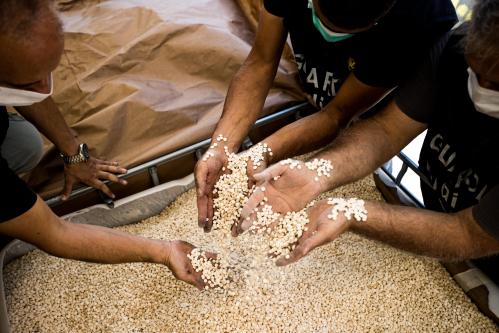Of late, Pakistan has struggled with its image in the West (notwithstanding U.S. President-elect Donald Trump’s “fantastic” assessment of the country). This image problem is not, as has been the case in recent years, a product of terrorist attacks in Pakistan, nor its links to terrorists attacking Western targets—but because of cross-border terrorism that India lays at Pakistan’s feet and India’s insistence, because of that, that Pakistan be labeled a terrorist state. Pakistan’s response has been less than imaginative. It has issued denials and sent out image “restorers” in the form of a senator and a member of parliament to Washington, D.C. It also seeks to convince the world that India, too, sponsors terrorism in Pakistan. But words and public relations are not the answer. Pakistan needs to fix reality, not just its image.
That Pakistan needs to end its preferential treatment of anti-India jihadists and the Afghan Taliban, whose presence in Pakistan makes the country deeply unpopular in Afghanistan, is clear, at least to analysts. We understand that there are no good jihadis, that the lines between militant groups are blurred, and that militant foot soldiers migrate across groups with different objectives. But it’s worth understanding that ending Pakistan’s good-Taliban, bad-Taliban policy alone—if and when it happens—won’t fix things. That policy is only a symptom of the actual, far deeper problem—Pakistan’s national narrative.
This narrative argues that Pakistan’s existence is threatened by India, and that the nation’s defining feature is religion. This goes back to the 1947 Partition that resulted in a Muslim-majority Pakistan and a Hindu-majority India. Its roots also lie in the strategic calculations of Pakistan’s establishment post-partition. The willingness to conflate religion and war, and the legitimization of jihad is a direct byproduct of this narrative. The effect has been corrosive, and it has resulted in the opposite of a secure Pakistan.
What’s more, a narrative based on fear and an ideology of persecution cannot stimulate genuine and sustainable progress—though it may serve the narrow and short-term interests of the ruling elite and cement their power. To advance, Pakistan needs a new narrative. It doesn’t have to look far: Its founder Mohammad Ali Jinnah’s vision of a modern Muslim democracy is as relevant today as it was 70 years ago. Paying lip service to “Quaid’s Pakistan” (Jinnah is known in Pakistan as the “Quaid-e-Azam,” the great leader) will not be sufficient, nor will the efforts of domestic image restorers observing Christmas celebrations this past December. Such gestures, while welcome, are not enough. Pakistan needs to give Jinnah’s vision of a democratic and modern Pakistan concrete form and expression.
Unfortunately, Pakistan is far from this: Its economy is weak, and its democratic politics flawed. Yet there are positive signs that a new narrative could emerge—fledgling and hesitant though they may be.
Pakistani politics—defined through the decades by military dominance and two corrupt parties alternately holding power—requires a transformation.
Pakistani politics—defined through the decades by military dominance and two corrupt parties alternately holding power—requires a transformation. As a start, its two major parties need robust competition that can incentivize their politicians to behave better. Unfortunately, Pakistan’s third party, the Tehreek-e-Insaaf, has failed in that role: Its leader Imran Khan’s protests and extra-parliamentary behavior have not been conducive to the cause of democracy. Prime Minister Nawaz Sharif’s corruption scandals have not helped either. Beyond party competition, Pakistani democracy also needs lower barriers to entry into politics, non-dynastic leadership of major parties, and a new wave of first-generation political entrepreneurs who are different from the establishment elite.
That’s a long list. Nevertheless, the trends are positive, though the day-to-day turbulence of Pakistani politics could fool you. In recent years the military has shown restraint (though it maintains a dominant posture). And Pakistanis remain solidly committed to democracy. In a June 2016 Gallup poll, 84 percent of respondents said they preferred democracy to dictatorship.
Economic growth, robust and sustained, can also help seed a new narrative. While there are shiny new infrastructure projects in Pakistan’s (mainly Punjab’s) big cities (the ruling Pakistan Muslim League’s obsession) and the state rests great hopes in Chinese investment, what Pakistan really needs is a new culture of economic entrepreneurship. This requires first generation entrepreneurs who can serve as new role models for the youth—offering a real alternative to militancy. In the information technology sector, entrepreneurs need two things: engineering skills and a computer. That is where success stories are starting to emerge, with bright young Pakistani entrepreneurs making a mark developing software. But these startups have yet to make a transformative global impact (like India’s Infosys or China’s Alibaba) in a way that would change Pakistan’s direction and narrative.
To become true entrepreneurs, Pakistanis need to be able to acquire skills and capital. Better skills require a better education system (Pakistan has a few excellent elite universities, but they alone won’t do the trick); capital requires a stronger financial sector. There are deep, state-level reforms required in these sectors. But the state also needs to foster a culture of risk-taking and experimentation that is looking to define a new future, rather than being held hostage to history.
While such reform priorities may seem out of reach or overly ambitious, they are nonetheless resolutions worth embracing at the start of 2017. If Pakistan starts taking steps in this direction, it won’t need image restorers and public relations campaigns any longer.







Commentary
Redefining Pakistan
January 11, 2017